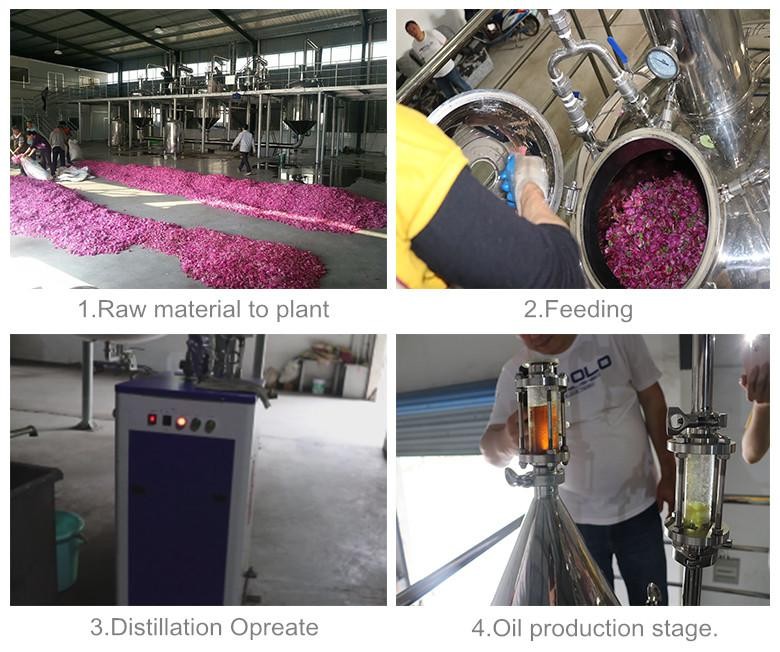The essential oils we see in daily life are all extracted from aromatic plants.
What are aromatic plants?
Plants that contain organs capable of secreting aromatic substances can be called aromatic plants, and these organs can exist in different parts of the plant body, but only the organs that secrete the largest amount of aromatic substances will be used, which means that plants have the most useful value part.


Essential oils, extraction, aromatic plants, distillation
There are currently three mature plant essential oil extraction methods, and I will introduce them in detail below.
1.Distillation method
Distillation method is currently the most common essential oil extraction method. More than 95% of the essential oils on the market are extracted by this method, because the distillation method has the simplest operation and the lowest cost, and is most suitable for large-scale mass production.
The method is to put fresh or dried aromatic plant raw materials (flowers, leaves, wood chips, etc.) into the distiller, heating from below to send water vapor, the high temperature steam will evaporate the essential oil components in the aromatic plants. Then the steam containing essential oils will continue to enter the condenser along the pipe. The low-temperature condenser wall will liquefy the steam and turn it into a liquid form, and then flow into the collection bottle, because the essential oil and water have different specific gravity and are insoluble in water. When the essential oil is lighter than water, it will float on the water. When the essential oil is heavier than water, it will sink to the bottom, so that the water and the essential oil can be easily separated, so the essential oil is extracted.
The distillation method is mostly used to extract aromatic plants whose parts are roots, stems, flowers and leaves. In the cooling process, the circulating water can be used many times, and in the born water, some essential oils are more or less dissolved in it. This is the so-called “flower water”, which is the “pure dew” on the market. “, “Pure Honey”.
The more common lavender essential oil, tea tree essential oil, eucalyptus essential oil, geranium essential oil, etc. are mostly extracted by distillation.
essential oil, extraction, aromatic plant, distillation
2.Extrusion method
Extrusion method is often used to extract citrus essential oils. Most of the citrus essential oils are not resistant to high temperatures. The distillation method will break the essential oil composition, so citrus essential oils are mostly extracted by the extrusion method.
The method is to directly squeeze the peels of aromatic plants, manually or by machines (mostly machines), and then extract the essential oils.
The method is very simple, but there must be a premise, that is, the content of essential oils in the plant must be very rich. Therefore, the extrusion method can only be used to extract citrus essential oils.
The more common lemon essential oil, grapefruit essential oil, orange essential oil, and bergamot essential oil are mostly extracted by extrusion.
3. Solvent extraction method
Compared with the previous two methods, the solvent extraction method has a much higher cost, and is mainly used as an extraction method for floral essential oils.
The method is to use alcohol, ether, liquid butane and other solvents to repeatedly pour on the petals of aromatic plants, then separate and analyze the solvent containing essential oils, and finally extract the essential oils by low-temperature distillation.
Solvent extraction method is the latest extraction method. Essential oils extracted by sub-methods usually contain very complete and precious essential oil components. Distillation method will more or less destroy some of the essential oil components due to high temperature, so solvent extraction method extracts The price of essential oils is usually higher.
The more common rose essential oil, jasmine essential oil, cinnamon essential oil, neroli essential oil, etc. are mostly extracted by solvent extraction.
essential oil, extraction, aromatic plant, distillation
There are actually two essential oil extraction methods: liposuction and carbon dioxide extraction.
It’s just that these two methods are very time-consuming and labor-intensive and are not suitable for large-scale commercial production, so they are gradually replaced by the first three methods. I won’t introduce them here.
warm words: Don’t think that this knowledge is useless for ordinary consumers like you and me. Knowing the extraction methods of essential oils can help you understand the characteristics, quality, and price of essential oils.
Characteristics: For example, the chemical composition of citrus essential oils is easy to change when heated, so you should pay attention to the temperature when storing, and the shelf life is shorter than other essential oils.
Quality: The quality of essential oils obtained by different extraction methods is greatly different. For example, rose essential oil extracted by distillation and rose essential oil extracted by solvent extraction are different in quality. Rose essential oil extracted by solvent extraction has better quality.
Price: The more complex the extraction process, the higher the price of essential oils, and the better the quality. The price of essential oils extracted by solvent extraction is usually the highest.
